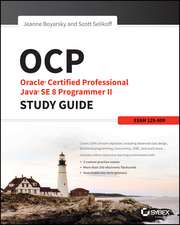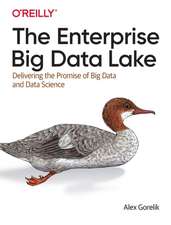Genetic Programming and Data Structures: Genetic Programming + Data Structures = Automatic Programming!: Genetic Programming, cartea 1
Autor William B. Langdonen Limba Engleză Hardback – 30 apr 1998
This book is motivated by the observation from software engineering that data abstraction (e.g., via abstract data types) is essential in programs created by human programmers. This book shows that abstract data types can be similarly beneficial to the automatic production of programs using GP.
Genetic Programming and Data Structures: Genetic Programming + Data Structures = Automatic Programming! shows how abstract data types (stacks, queues and lists) can be evolved using genetic programming, demonstrates how GP can evolve general programs which solve the nested brackets problem, recognises a Dyck context free language, and implements a simple four function calculator. In these cases, an appropriate data structure is beneficial compared to simple indexed memory. This book also includes a survey of GP, with a critical review of experiments with evolving memory, and reports investigations of real world electrical network maintenance scheduling problems that demonstrate that Genetic Algorithms can find low cost viable solutions to such problems.
Genetic Programming and Data Structures: Genetic Programming + Data Structures = Automatic Programming! should be of direct interest to computer scientists doing research on genetic programming, genetic algorithms, data structures, and artificial intelligence. In addition, this book will be of interest to practitioners working in all of these areas and to those interested in automatic programming.
| Toate formatele și edițiile | Preț | Express |
|---|---|---|
| Paperback (1) | 986.99 lei 6-8 săpt. | |
| Springer Us – 29 oct 2012 | 986.99 lei 6-8 săpt. | |
| Hardback (1) | 994.08 lei 6-8 săpt. | |
| Springer Us – 30 apr 1998 | 994.08 lei 6-8 săpt. |
Preț: 994.08 lei
Preț vechi: 1242.59 lei
-20% Nou
Puncte Express: 1491
Preț estimativ în valută:
190.21€ • 199.13$ • 157.39£
190.21€ • 199.13$ • 157.39£
Carte tipărită la comandă
Livrare economică 05-19 aprilie
Preluare comenzi: 021 569.72.76
Specificații
ISBN-13: 9780792381358
ISBN-10: 0792381351
Pagini: 279
Ilustrații: XIII, 279 p.
Dimensiuni: 155 x 235 x 24 mm
Greutate: 0.61 kg
Ediția:1998
Editura: Springer Us
Colecția Springer
Seria Genetic Programming
Locul publicării:New York, NY, United States
ISBN-10: 0792381351
Pagini: 279
Ilustrații: XIII, 279 p.
Dimensiuni: 155 x 235 x 24 mm
Greutate: 0.61 kg
Ediția:1998
Editura: Springer Us
Colecția Springer
Seria Genetic Programming
Locul publicării:New York, NY, United States
Public țintă
ResearchCuprins
1. Introduction.- 1.1 What is Genetic Programming?.- 1.2 Motivation.- 1.3 Outline.- 2. Survey.- 2.1 Introduction.- 2.2 Genetic Algorithms.- 2.3 Genetic Programming.- 2.4 GP Research.- 2.5 GP Applications.- 2.6 Conclusions.- 3. Advanced Genetic Programming Techniques.- 3.1 Background.- 3.2 Tournament Selection.- 3.3 Steady State Populations.- 3.4 Indexed memory.- 3.5 Scalar Memory.- 3.6 Multi-tree programs.- 3.7 Directed Crossover.- 3.8 Demes.- 3.9 Pareto Optimality.- 3.10 Conclusions.- 4. Evolving a Stack.- 4.1 Problem Statement.- 4.2 Architecture.- 4.3 Choice of Primitives.- 4.4 Fitness Function.- 4.5 Parameters.- 4.6 Results.- 4.7 Summary.- 5. Evolving a Queue.- 5.1 Problem Statement.- 5.2 Architecture.- 5.3 Choice of Primitives.- 5.4 Fitness Functions.- 5.5 Parameters.- 5.6 Automatically Defined Functions.- 5.7 Evolved Solutions — Caterpillar.- 5.8 Evolved Programs — Shuffler.- 5.9 Circular Buffer — Given Modulus Increment.- 5.10 Circular Buffer — Evolving Modulus Increment.- 5.11 Discussion: Building Blocks and Introns.- 5.12 Summary.- 6. Evolving a List.- 6.1 Problem Statement.- 6.2 Architecture.- 6.3 Automatically Defined Functions.- 6.4 Choice of Primitives.- 6.5 Fitness Function.- 6.6 Directed Crossover.- 6.7 Parameters.- 6.8 Results.- 6.9 Software Maintenance.- 6.10 Discussion.- 6.11 Conclusions.- 7. Problems Solved Using Data Structures.- 7.1 Balanced Bracket Problem.- 7.2 Dyck Language.- 7.3 Evaluating Reverse Polish Expressions.- 7.4 Work by Others on Solving Problems with Memory.- 7.5 Summary.- 8. Evolution of GP Populations.- 8.1 Price’s Selection and Covariance Theorem.- 8.2 Fisher’s Fundamental Theorem of Natural Selection.- 8.3 Evolution of Stack Problem Populations.- 8.4 Loss of Variety.- 8.5 Measurements of GP Crossover’s Effects.- 8.6Discussion.- 8.7 Summary.- 9. Conclusions.- 9.1 Recommendations.- 9.2 Future work.- References.- Appendices.- A–Number of Fitness Evaluations Required.- B–Glossary.- C–Scheduling Planned Maintenance of the National Grid.- C.1 Introduction.- C.2 The Electricity Transmission Network in Great Britain.- C.3 The South Wales Region of the UK Electricity Network.- C.4 Approximating Replacement Generation Costs.- C.5 The Fitness Function.- C.6 The Chromosome.- C.7 Greedy Optimisers.- C.8 South Wales Problem without Contingencies.- C.9 South Wales and Genetic Programming.- C.10 South Wales Problem with Contingencies.- C.11 Conclusions.- C.12 Future Work.- C.13 Using QGAME.- D–Implementation.- D.1 GP-QUICK.- D.2 Coding Changes to GP-QUICK-2.1.- D.3 Default Parameters.- D.4 Network Running.- D.5 Reusing Ancestors Fitness Information.- D.6 Caches.- D.7 Compressing the Check Point File.- D.8 Benchmarks.- D.9 Code.
Recenzii
`The book is nicely produced ... and well illustrated. The text is well written and is easy to read and understand. The concepts in genetic programming are well presented, as are those in genetic algorithms. The references are selected to be useful. People of a non-mathematical disposition will find few problems in reading this book.'
Robotica, 17 (1999)
Robotica, 17 (1999)






















